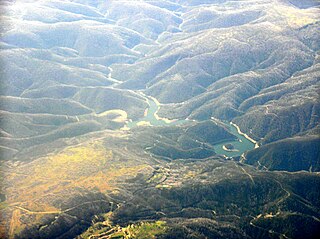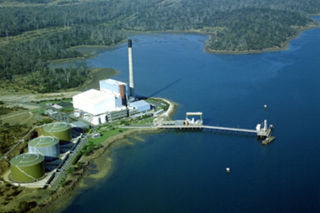
A power station, also referred to as a power plant and sometimes generating station or generating plant, is an industrial facility for the generation of electric power. Power stations are generally connected to an electrical grid.

Pumped-storage hydroelectricity (PSH), or pumped hydroelectric energy storage (PHES), is a type of hydroelectric energy storage used by electric power systems for load balancing. The method stores energy in the form of gravitational potential energy of water, pumped from a lower elevation reservoir to a higher elevation. Low-cost surplus off-peak electric power is typically used to run the pumps. During periods of high electrical demand, the stored water is released through turbines to produce electric power. Although the losses of the pumping process make the plant a net consumer of energy overall, the system increases revenue by selling more electricity during periods of peak demand, when electricity prices are highest. If the upper lake collects significant rainfall or is fed by a river then the plant may be a net energy producer in the manner of a traditional hydroelectric plant.

Hydroelectricity, or hydroelectric power, is electricity generated from hydropower. Hydropower supplies one sixth of the world's electricity, almost 4500 TWh in 2020, which is more than all other renewable sources combined and also more than nuclear power. Hydropower can provide large amounts of low-carbon electricity on demand, making it a key element for creating secure and clean electricity supply systems. A hydroelectric power station that has a dam and reservoir is a flexible source, since the amount of electricity produced can be increased or decreased in seconds or minutes in response to varying electricity demand. Once a hydroelectric complex is constructed, it produces no direct waste, and almost always emits considerably less greenhouse gas than fossil fuel-powered energy plants. However, when constructed in lowland rainforest areas, where part of the forest is inundated, substantial amounts of greenhouse gases may be emitted.

Duke Energy Corporation is an American electric power and natural gas holding company headquartered in Charlotte, North Carolina.
Snowy Hydro Limited is an electricity generation and retailing company in Australia that owns, manages, and maintains the Snowy Mountains Hydro-electric Scheme which consists of nine hydro-electric power stations and sixteen large dams connected by 145 kilometres (90 mi) of tunnels and 80 kilometres (50 mi) of aqueducts located mainly in the Kosciuszko National Park. Snowy Hydro also owns and operates two gas-fired power stations in Victoria and one in New South Wales, three diesel power stations in South Australia and owns two electricity retailing businesses, Red Energy and Lumo Energy.

The Murray Region Hydroelectric Power Stations refers to two of the original seven hydroelectric power stations, both located near the town of Khancoban in the Snowy Mountains region of New South Wales, Australia. The two power stations are part of the Snowy Mountains Scheme, a vast hydroelectricity and irrigation complex constructed in south-east Australia between 1949 and 1974 and now run by Snowy Hydro. Although both power stations are physically located in New South Wales, since 1 July 2008 all power generated has been allocated to the Victorian region of the National Electricity Market. The stations are not located on the Murray River.

The Tumut Hydroelectric Power Stations is a series of three hydroelectric power stations on the Tumut River in New South Wales, Australia, that are part of the Snowy Mountains Scheme.

The Kiewa Hydroelectric Scheme is the largest hydro-electric scheme in the Australian state of Victoria and the second-largest in mainland Australia after the Snowy Mountains Scheme. The scheme is situated in the Australian Alps in north-eastern Victoria about 350 kilometres from Melbourne and is wholly owned by AGL Energy.

The Bell Bay Power Station was a power station located in Bell Bay, on the Tamar River, Tasmania, Australia, adjacent to the Tamar Valley Power Station, with which it was often confused. It was commissioned between 1971 and 1974 as an oil fired thermal power station, and was converted to natural gas in 2003, after the commissioning of the Tasmanian Gas Pipeline, a submarine gas pipeline which transports natural gas from Longford, Victoria, under Bass Strait, to Bell Bay, Tasmania. As the power station's primary role was to provide system security in the event of drought for Tasmania's predominantly hydro-electric based generation system it only was rarely called on to operate, resulting in intervals of five to eight years between periods of significant use. After the commissioning of Basslink in 2006, the power station was decommissioned in 2009.

Laverton North Power Station is a natural gas-powered plant, owned and operated by Snowy Hydro Limited. It is situated in Laverton North, on the south-western outskirts of Melbourne, Victoria, approximately 15 km from the Melbourne Central Business District. It is a peaking power plant, particularly constructed to cater for the growth in Victoria's summer electricity demand, and can be rapidly activated when required.

AGL Energy Ltd is an Australian listed public company involved in both the generation and retailing of electricity and gas for residential and commercial use. AGL is Australia's largest electricity generator, and the nation's largest carbon emitter. In 2014, the company had an operated generation capacity of 10,984 MW. The company emitted 42,227,180 Total Scope 1 Emissions in 2019-20 and 40,209,034 t CO2-e in 2020–21. AGL is also a significant investor, owner, and operator, of renewable energy assets.

Contact Energy Limited is a New Zealand electricity generator, a wholesaler of natural gas, and a retailer of electricity, natural gas, broadband and LPG.
The Stratford Power Station is a 577 MW power station located east of Stratford, in Taranaki, New Zealand. The original power station on the site was a 200 MW gas turbine power plant that opened in 1976 and closed in 2001. The current power station comprises a 377 MW combined cycle unit that opened in 1998 and two open cycle gas turbine units for peaking power that opened in 2011. The station is now owned and operated by Contact Energy.
The Whirinaki Power Station is an open cycle gas turbine power station at Whirinaki in Hawke's Bay, New Zealand.
Tamar Valley Power Station is a $230 million natural gas-fired power station located in Bell Bay in the Tamar Valley, Tasmania. It is owned by Hydro Tasmania, and is immediately adjacent to the decommissioned Bell Bay Power Station, which is also owned by Hydro Tasmania.
Colongra Gas Generation Plant is a 667 MW gas-fired power station located in Colongra, New South Wales, Australia and is the largest gas-fired power station in New South Wales. It will generally be used during peak demand periods in New South Wales.
Lonsdale Power Station is a diesel-powered electricity generator in South Australia in Lonsdale, an industrial southern suburb of Adelaide. It is owned by Snowy Hydro since 2014. It consists of 18 diesel reciprocating engines generating up to 21MW of electricity to meet peak demands in the National Electricity Market.











